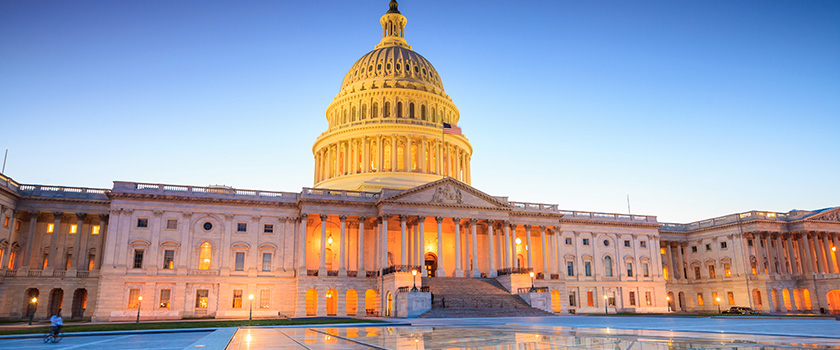Key points :
- With the formal campaign season having barely begun, the American President will likely turn to an economic recovery narrative supported by recent strong data and the prospect of as much as USD 1 trillion in potential stimulus currently held at the US Treasury in the months ahead.
- Looking back as far as 1928, when the incumbent party loses the Presidency, markets have declined 80% of the time in the run-up to the election warranting caution should polls hold up in the summer.
- Indeed, should the Democratic nominee, Joe Biden take office in 2021, the most significant shift for investors may be a partial reversal of the 2017 US corporate tax reform. With markets focused on the prospect of a stimulus-driven V-shaped recovery in the US economy and corporate earnings, higher taxes in the coming year currently appear unpriced in markets.
- A Biden infrastructure programme has the potential however to add infrastructure transformation to long-cycle transformations taking place in the US and global economies as they emerge from lockdown.
- A Biden presidency may quiet the bellicose US-China rhetoric and allow more proactive Chinese policies to reshape the domestic economy. Globally, the change will likely not stop but rather spur reconfiguration of the geopolitical landscape and drive re-shoring activity across economies.
The prospect of a November Democratic victory grows
Betting markets have seen a dramatic narrowing in the re-election prospects for US President Donald Trump following the onset of the US phase of the global Coronavirus crisis leaving them pricing the lowest probability of him recapturing the White House since mid-2019.
Admittedly, polls of voters are showing presumptive Democratic nominee, former Vice President Joe Biden widening his polling lead against the incumbent, though the 7% polling gap between the candidates remains well short of the 10-12% gap that favoured then-candidate Joe Biden in late-2019 at the height of the US-China trade war.
Given the complexities of the Electoral College system for US Presidential elections, focusing on the key ‘swing’ states that tilted the 2016 election in favour of Donald Trump, in 2020, these states prefer Democratic challenger, Joe Biden by 10% in Michigan and +6-7% in Florida and Wisconsin. This suggests that the hurdles to re-election are indeed formidable for the sitting President.
As importantly, the race for control of the United States Congress also looks to be shifting in favour of the Biden-led Democratic Party. With Democrats already controlling the US House of Representatives and likely to continue to do so in 2021, the focus is on the Republican’s ability to hold its majority in the US Senate in order to stand as an obstacle to a Democratic Presidential agenda in the event that the White House is lost.
Currently, seven of the 100 seats are competitive between Republican and Democratic candidates with four seats required to shift to give the Democrats control of both houses of Congress. With Democratic candidates polling with a 7-10% lead in four of the seven seats, the prospect of a full Democratic sweep and a relatively unfettered road to implement policy objectives on inauguration day is becoming increasingly clear.
So, while four months still remain until voters go to the ballot box, the current landscape offers the Democrats their best hope of regaining control of both the executive and legislative branches since 2008.
Closing the gap strategy 1: Stimulus
With the formal campaign season having barely begun in the United States, the American President will likely have to rely on a campaign focusing on a recovery in economic momentum to rally his admittedly committed base of voters moving into November.
With lockdowns having begun to ease in May, the US economy is already witnessing the same inflection in activity seen in China and Europe post-lockdown.
However, the renewed outbreaks in key states including Texas, Arizona and Florida pose a threat to this recovery narrative; investors should be aware that both the US Federal Reserve as well as the US Treasury hold significant resources in reserve should the US economy once again stumble.
In particular, though the Federal Reserve has been vocal about the new liquidity facilities put at its disposal since March, 2020, in fact the American central bank has not deployed much of the ammunition it has been provided with. Instead, Fed Chair Jerome Powell has leaned more heavily on traditional measures via the nearly USD 3 trillion in purchases of Treasury and mortgage-backed securities and via the communications channel.
That leaves nearly a comparable amount of monetary stimulus potential in reserve via these new liquidity facilities as the Fed deployed to arrest the shock to the economy triggered by the pandemic-induced lockdowns back in March.
American fiscal authorities have been disbursing payments from the USD 2-3 trillion CARES Act in support of households and companies following the COVID-19 outbreak, the balance in the General Account has still ballooned to USD 1.6 trillion.
This indicates that the Treasury Secretary has been issuing Treasury securities (which the Federal Reserve has been indirectly purchasing) at a pace that exceeds its disbursements by USD 1.2 trillion. These funds could yet serve to inject fiscal stimulus into the US economy should the US executive branch deem it necessary.
Closing the gap strategy 2: Geopolitical Conflict
With the American President now well behind in the polls, investors should also be aware of a risk that he may resort to sparking a conflict internationally to rally domestic voters.
Indeed, the administration has already laid the foundation with renewed albeit to date, modest pressure on China’s access to advanced technology as well as adding a new front via Chinese access to USD capital markets.
Remember that the US has continued to extend waivers that allow Chinese 5G giant Huawei to have access to US providers. At the same time, the administration has added firms that comprise the Huawei supply chain to its Entities List limiting their access to advanced technologies. In addition, the administration has begun to tighten access to suppliers of the most advanced chips and equipment, some supplied from Taiwan. This makes Taiwan increasingly strategically important to both China – and its 5G/high tech ambitions – and the United States – and its efforts to contain the second largest economy in the world technologically.
Beyond this, the administration has opened up a new front in its conflict with China by targeting access to USD capital flows. Of course, an unacknowledged consequence of the 2018-19 trade war was a redirection of China’s inbound foreign direct investment flows as corporates diversified away from their China-centric supply chains. This served as the first drain on USD flows into China.
In the 2nd quarter of 2020, the US NASDAQ exchange tightened listing requirements and the US Senate passed legislation that effectively limited the ability of Chinese firms to list in the United States.
As a result, Chinese firms are increasingly turning to Hong Kong to raise capital offshore. However, while the US has announced the removal of the special status afforded the special administrative region of Hong Kong, additional measures have not yet followed leaving the open prospect of additional pressure on this key venue for USD capital raising by Chinese firms.
Should the US pursue further confrontational actions, the nature of Chinese retaliation may shift from the currency and tariff tools used in the trade war. With the Federal Reserve’s unconstrained quantitative easing measures and global trade still subdued, key soft tools available to China (sale of US Treasuries or devaluation of the CNY) are unlikely to be such effective responses in the current environment.
As a consequence, the tools China could turn to may increasingly pivot to non-trade, geopolitical avenues escalating the conflict to a new battlefield.
A Biden Presidency Implications 1 – Increased Corporate Taxes
We expect the Trump administration to deploy the full range of measures at its disposal in its quest to recapture the White House. In the event that their efforts fail, the implications of a Biden presidency will likely be significant for investors.
In aggregate, with a change in party in the White House, investors should expect a realignment of some key policy positions with the new administration.
First, looking back as far as 1928, when the party in control of the White House changes hands, this has translated into weak markets going into the actual November election. In contrast, when markets are confident of an incumbent party victory, irrespective of whether they are Republican or Democrat, 92% of such episodes have resulted in a positive return on the S&P 500 in the three months going into the election.
Indeed, under a Biden presidency, such market concern may arise from worries about corporate profits with his proposed tax plan partially reversing the 2017 Trump tax cuts by raising corporate taxes from 21% to 28% while establishing a minimum corporate tax rate of 15%.
The Biden plan also includes measures that would increase taxes on ‘global intangible low-taxed income’ (GILTI) from 10.5% to 21%. This was the measure that encouraged repatriation of foreign income spurring buybacks in 2018.
With markets, by our calculations already largely pricing in the prospect of a full corporate earnings recovery in 2021 back to prerecession levels, the potential for not only increased corporate tax rates but also a wider corporate tax net is likely underestimated by current earnings expectations for 2021.
A Biden Presidency Implications 2 – Infrastructure/Green Spending Programmes
Despite increased corporate taxes, budget deficits should remain large as rising corporate taxes will likely be paired with infrastructure as well as other spending programmes to achieve both economic and social objectives. In particular, the Biden campaign has outlined an infrastructure programme to both restore a crumbling national infrastructure but also with a focus on associated jobs and training. There is also a commitment to build greener and more connected public transport.
Though reported US budget deficits have already reached nearly 10% of GDP in mid-2020, much of that spending has shifted to replace income lost as a result of the lockdown across the economy from March-May.
Should fiscal policy pivot strongly from income replacement measures to long-cycle spending on productivity enhancing infrastructure spending, this may begin to narrow the performance and valuation gaps that have emerged between growth and value stocks.
That said, while the proposed Biden infrastructure programme will have traditional components (e.g. roads, bridges, rail), it will also incorporate a significant share of spending to serve as a catalyst to spur transformation of the American infrastructure. This may create new ‘growth’ oriented opportunities much as the COVID-19 pandemic and associated lockdown have spurred the acceleration of the transformation and emergence of new growth segments in other aspects of the American economy.
Indeed, the prospect of a Biden presidency should add infrastructure transformation to the long-cycle transformations we have been focusing on in the post-COVID regime beyond the economic, corporate and household transformations now underway.
A Biden Presidency Implications 3 – Reshaping US international relations
A key hallmark of the Trump presidency has been his ‘America First’ approach to US relationships around the world. A Biden presidency would likely return the US towards a more multilateral approach especially among the world’s liberal democracies.
Admittedly, many ‘allies’ may be reluctant partners given the diverging interest in recent years; should it at least begin to thaw ties across the Atlantic in particular, it could also restore a more formidable counterbalance to China’s rising power in the world.
Indeed, though the European Union has distanced itself from the Trump administration’s approach to confronting China, increasingly, its leaders have expressed their own concern about China’s policies across a wide range of topics. In fact, after the recently completed EU-China summit, European Commission President Ursula von der Leyen cajoled China to ‘match our level of ambition’ on yet unfulfilled Chinese promises on climate change, investment industrial subsidies, trade and human rights.
Moreover, in recent weeks, the EU has begun implementing a mechanism to shield strategic European industries from predatory acquisitions following a spate of Chinese takeovers in recent years that has hollowed out portions of Europe’s industrial heartland.
Perhaps recognising this increasingly vocal tone, China has stepped back from an ongoing four-year dispute with the European Union at the World Trade Organization seeking to be classified as a ‘market economy’. Had it succeeded, the EU would have been limited in its tools to combat ‘dumping’ of lowcost Chinese exports on the continent. Separately, the US is also engaged in a similar dispute with China over its status.
So, while a Biden presidency will likely ease the bellicose rhetoric that has characterised the US-China relationship under the Trump administration, it may give way in favour of a cautiously rekindled multilateral partnership to continue reshaping China’s relationship with the rest of the world.
For investors, it suggests that the re-shoring of supply chains that began with the US-China trade war of 2018-19 and accelerated as a result of COVID-19 lockdowns should not only continue but also perhaps increasingly become incentivised by policy such as the EU’s new regulations on cross border takeovers or Japan’s recent outright subsidies to corporations to return activities onshore.
Should the spectre of an aggressive confrontation with the US ease under a Biden presidency, this may also allow China to refocus its own domestic transformation agenda. Indeed, despite being first to emerge from lockdown among major economies, China has yet to pivot fully to recovery-oriented stimulus programmes to re-accelerate growth in a meaningful way.
While part of this may be due to an understandable abundance of caution in light of the ongoing pandemic in many nations in the world, some may be due to a lingering uncertainty about American policy intentions in the months going into the November elections. Should these uncertainties fade, the cyclical and long-cycle opportunities in a reforming China can once again move into the spotlight for investors.

Michaël Lok
Group Chief Investment Officer (CIO)
and Co-CEO Asset Management

Norman Villamin
Chief Investment Officer (CIO)
Wealth Management and
Head of Asset Allocation

Patrice Gautry
Chief Economist

Yves Cortellini
Deputy Head of Asset Allocation

